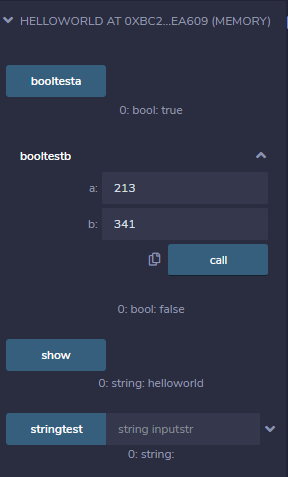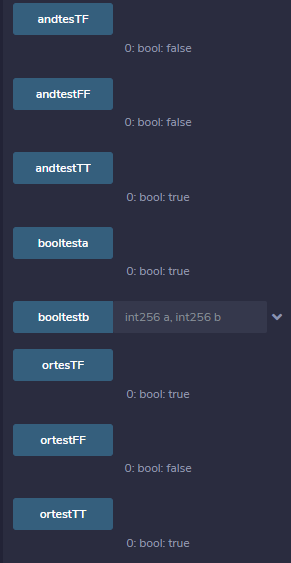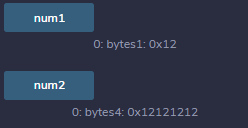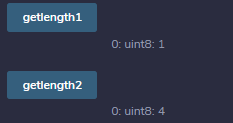1.solidity的四种可见度/访问权限
public:任何人都可以调用该函数,包括DApp的使用者。
private:只有合约本身可以调用该函数(在另一个函数中)。
internal:只有这份合同以及由此产生的所有合同才能称之为合同。
external:只有外部可以调用该函数,而合约内部不能调用。
2.solidity的三种修饰符
view: 可以自由调用,因为它只是“查看”区块链的状态而不改变它
pure: 也可以自由调用,既不读取也不写入区块链
payable:常常用于将代币发送给合约地址。
3.一个solidity的函数应有以下部分组成
function
你的函数名字(类型1 名字,类型2 名字,。。。,类型n 名字) 如果没有就什么都不填即可
可见度/访问权限,即public/private/internal/external 如果不写则系统默认为public并且警告
修饰符,即view/pure/payable 如果需要花费gas则不写
returns(类型1 名字,类型2 名字,。。。,类型n 名字) PS.如果有的话
注意:调用函数时如果需要输入字符串,则在输入框之内需要将字符串用双引号括起来。
尝试了一下最新的网页版不加双引号也可以成功,可能是更新之后新增的功能,具体见图
pragma solidity ^0.4.0;
contract helloworld {
function stringtest(string inputstr) public view returns(string){
return inputstr;
}
}

4.布尔类型
pragma solidity ^0.4.0;
contract helloworld {
bool boola=true; //声明一个布尔类型的值,只用一个等号
function booltesta() public view returns(bool){
return boola;
}
function booltestb(int a,int b) public view returns(bool){
return a==b;
}
}
测试结果

5.与,或
即&&,||
pragma solidity ^0.4.0;
contract helloworld {
function andtestTT() public view returns(bool){
return true&&true;
}
function andtesTF() public view returns(bool){
return true&&false;
}
function andtestFF() public view returns(bool){
return false&&false;
}
function ortestTT() public view returns(bool){
return true||true;
}
function ortesTF() public view returns(bool){
return true||false;
}
function ortestFF() public view returns(bool){
return false||false;
}
}
测试结果

6.通常运算符
即+,-,*,/,%以及特殊的符号**代表x的x次幂
pragma solidity ^0.4.0;
contract helloworld {
function jiatest(int a,int b) public view returns(int){
return a+b;
}
function jiantest(int a,int b) public view returns(int){
return a-b;
}
function chengtest(int a,int b) public view returns(int){
return a*b;
}
function chutest(int a,int b) public view returns(int){
return a/b;
}
function quyutest(int a,int b) public view returns(int){
return a%b;
}
function mitest(uint a,uint b) public view returns(uint){
return a**b; //此处必须为uint,直接写int256会报错
}
}
测试结果

7.位运算符
1.& 操作数之间转换成二进制之后每位进行与运算操作(同1取1)
2.| 操作数之间转换成二进制之后每位进行或运算操作(有1取1)
3.~ 操作数转换成二进制之后每位进行取反操作(直接相反)
4.^ 操作数之间转换成二进制之后每位进行异或操作(不同取1)
5.<<操作数转换成二进制之后每位向左移动x位的操作
6.>>操作数转换成二进制之后每位向右移动x位的操作
举例
pragma solidity ^0.4.0;
contract helloworld {
function Wyutest(uint8 a,uint8 b) public view returns(uint8){
return a&b;
}
function Whuotest(uint8 a,uint8 b) public view returns(uint8){
return a|b;
}
function Wfantest(uint8 a) public view returns(uint8){
return ~a;
}
function Wyihuotest(uint8 a,uint8 b) public view returns(uint8){
return a^b;
}
function zuoyitest(uint8 a,uint8 b) public view returns(uint8){
return a<<b;
}
function youyitest(uint8 a,uint8 b) public view returns(uint8){
return a>>b;
}
}
运行结果

8.solidity中赋值
solidity是先将赋值语句之中所有的都计算出来之后再进行赋值操作的
举例
pragma solidity ^0.4.0;
contract helloworld {
function setvaluetest() public view returns(uint8){
return 9999999999999999999-9999999999999999998;
}
}
测试结果

9.固定长度字节数组byte
一个byte=8个位(XXXX XXXX)X为0或1,二进制表示
byte数组为bytes1,bytes2,。。。,bytes32,以八个位递增,即是对位的封装
举例
bytes1=uint8
bytes2=unit16
。
。
。
bytes32=unit256
使用byte数组的理由:
1.bytesX可以更好地显示16进制
举例:bytes1=0x6A,bytes1=(XXXX XXXX)正好四个表示一个16进制,以此类推
2.bytes数据声明时加入public可以自动生成调用长度的函数,见下
pragma solidity ^0.4.0;
contract helloworld {
bytes1 public num1 = 0x12;
bytes4 public num2 = 0x12121212;
}

3.bytes内部自带length长度函数,而且长度固定,而且长度不可以被修改。见下
pragma solidity ^0.4.0;
contract helloworld {
bytes1 public num1 = 0x12;
bytes4 public num2 = 0x12121212;
function getlength1() public view returns(uint8){
return num1.length;
}
function getlength2() public view returns(uint8){
return num2.length;
}

4.字节数组可以进行大小比较
pragma solidity ^0.4.0;
contract helloworld {
bytes1 public num1 = 0x12;
bytes4 public num2 = 0x12121212;
uint8 num3 = 0x12;
uint8 num4 = 12;
function compare1() public view returns(bool){
return num1<num2;
}
function compare2() public view returns(bool){
return num1>num2;
}
function compare3() public view returns(bool){
//return num1>num3;不管是16进制还是二进制,编译器都会报错,
//return num1>num4;说明无法进行byte和int之间的比较
}
}
10.可变长度byte数组
声明方法
bytes arr = new bytes(length);
举例
pragma solidity ^0.4.0;
contract helloworld {
bytes arr1 = new bytes(3);
function initarr() public view{
arr1[0]=0x12;
arr1[1]=0x34;
}
function getarrlength() public view returns(uint){
return arr1.length;
}
function arrchange() public {
arr1[0]=0x11; //
}
function arrlengthchange(uint a) public {
arr1.length=a; //
}
function pushtest() public {
arr1.push(0x56);
}
}
其他注意:注意操作时不要出现位溢出的情况,如uint8中的数值超过255或者为负。还有除数为0等等常见错误
本文所有代码见下
pragma solidity ^0.4.0;
contract helloworld {
function stringtest(string inputstr) public view returns(string){
return inputstr;
}
bool boola=true; //声明一个布尔类型的值,只用一个等号
function booltesta() public view returns(bool){
return boola;
}
function booltestb(int a,int b) public view returns(bool){
return a==b;
}
function andtestTT() public view returns(bool){
return true&&true;
}
function andtesTF() public view returns(bool){
return true&&false;
}
function andtestFF() public view returns(bool){
return false&&false;
}
function ortestTT() public view returns(bool){
return true||true;
}
function ortesTF() public view returns(bool){
return true||false;
}
function ortestFF() public view returns(bool){
return false||false;
}
function jiatest(int a,int b) public view returns(int){
return a+b;
}
function jiantest(int a,int b) public view returns(int){
return a-b;
}
function chengtest(int a,int b) public view returns(int){
return a*b;
}
function chutest(int a,int b) public view returns(int){
return a/b;
}
function quyutest(int a,int b) public view returns(int){
return a%b;
}
function mitest(uint a,uint b) public view returns(uint){
return a**b; //此处必须为uint,直接写int256会报错
}
function Wyutest(uint8 a,uint8 b) public view returns(uint8){
return a&b;
}
function Whuotest(uint8 a,uint8 b) public view returns(uint8){
return a|b;
}
function Wfantest(uint8 a) public view returns(uint8){
return ~a;
}
function Wyihuotest(uint8 a,uint8 b) public view returns(uint8){
return a^b;
}
function zuoyitest(uint8 a,uint8 b) public view returns(uint8){
return a<<b;
}
function youyitest(uint8 a,uint8 b) public view returns(uint8){
return a>>b;
}
function setvaluetest() public view returns(uint8){
return 9999999999999999999-9999999999999999998;
}
bytes1 public num1 = 0x12;
bytes4 public num2 = 0x12121212;
uint8 num3 = 0x12;
uint8 num4 = 12;
function getlength1() public view returns(uint8){
return num1.length;
}
function getlength2() public view returns(uint8){
return num2.length;
}
function compare1() public view returns(bool){
return num1<num2;
}
function compare2() public view returns(bool){
return num1>num2;
}
function compare3() public view returns(bool){
//return num1>num3;
//return num1>num4;
}
bytes arr1 = new bytes(3);
function initarr() public view{
arr1[0]=0x12;
arr1[1]=0x34;
}
function getarrlength() public view returns(uint){
return arr1.length;
}
function arrchange() public {
arr1[0]=0x11; //
}
function arrlengthchange(uint a) public {
arr1.length=a; //
}
function pushtest() public {
arr1.push(0x56);
}
}
